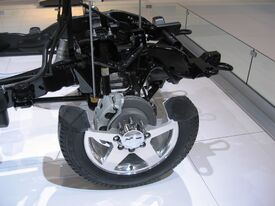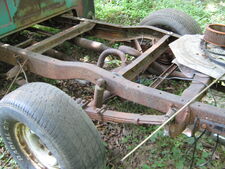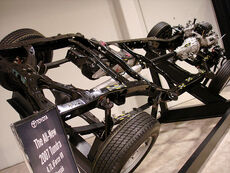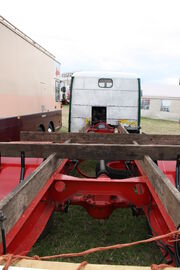
Cross section of a Chevy Silverado HD 2011 frame
A frame is the main structure of the chassis of a motor vehicle. All other components fasten to it; a term for this is design is body-on-frame construction.
In 1920, every motor vehicle other than a few cars based on motorcycles had a frame. Since then, nearly all cars have shifted to unit-body construction, while nearly all trucks and buses still use frames.
Construction[]
There are three main designs for frame rails. Their cross-sections include:
- C-shaped
- Boxed
- Hat
C-shape[]
By far the most common, the C-rail has been used on nearly every type of vehicle at one time or another. It is made by taking a flat piece of steel (usually ranging in thickness from 1/8" to 3/16") and rolling both sides over to form a c-shaped beam running the length of the vehicle.
Boxed[]
Originally, boxed frames were made by welding two matching c-rails together to form a rectangular tube. Modern techniques, however, use a process similar to making c-rails in that a piece of steel is bent into four sides and then seam welded where both edges meet (often made in continuous lengths like a tube).
In the 1960s, the boxed frames of conventional American cars were spot-welded here and there down the seam; when turned into NASCAR "stock car" racers, the box was continuously welded from end to end for extra strength (as was that of the Land-Rover from its first series).

1956 Chevrolet 1/2-ton frame. Notice hat-shaped crossmember in the background, c-shape rails and crossmember in center, and a slight arch over the axle.
Hat[]
Hat frames resemble a "U" and may be either right-side-up or inverted with the open area facing down. Not commonly used due to weakness and a propensity to rust, however they can be found on 1936-1954 Chevrolet cars and some Studebakers.
Abandoned for a while, the hat frame gained popularity again when companies started welding it to the bottom of unibody cars, in effect creating a boxed frame.
Design Features[]
While appearing at first glance as a simple hunk of metal, frames encounter great amounts of stress and are built accordingly. The first issue addressed is beam height, or the height of the vertical side of a frame. The taller the frame, the better it is able to resist vertical flex when force is applied to the top of the frame. This is the reason semi-trucks have taller frame rails than other vehicles instead of just being thicker.
Another factor considered when engineering a frame is torsional resistance, or the ability to resist twisting. This, and diamonding (one rail moving backwards or forwards in relation to the other rail), are countered by crossmembers. While hat-shaped crossmembers are the norm, these forces are best countered with "K" or "X"-shaped crossmembers.
As looks, ride quality, and handling became more of an issue with consumers, new shapes were incorporated into frames. The most obvious of these are arches and kick-ups. Instead of running straight over both axles, arched frames sit roughly level with their axles and curve up over the axles and then back down on the other side for bumper placement. Kick-ups do the same thing, but don't curve down on the other side, and are more common on front ends.
On perimeter frames, the areas where the rails connect from front to center and center to rear are weak compared to regular frames, so that section is boxed in, creating what's known as torque boxes.
Another feature seen are tapered rails that narrow vertically and/or horizontally in front of a vehicle's cabin. This is done mainly on trucks to save weight and slightly increase room for the engine since the front of the vehicle doesn't bear as much of a load as the back.

2007 Toyota Tundra chassis showing an x-shaped crossmember at the back.
The latest design element is frames that use more than one shape in the same frame rail. For example, the new Toyota Tundra uses a boxed frame in front of the cab, shorter, narrower rails underneath the cab for ride quality, and regular c-rails under the bed.
Types[]
Ladder Frame[]

A Truck ladderfame chassis fitted with the timber subframe and 2 cross members for the body
So named for its resemblance to a ladder, the ladder frame is the simplest and oldest of all designs. It consists merely of two symmetrical rails, or beams, and crossmembers connecting them. Originally seen on almost all vehicles, the ladder frame was gradually phased out on cars around the 1940s in favour of perimeter frames and is now seen mainly on trucks.
This design offers good beam resistance because of its continuous rails from front to rear, but poor resistance to torsion or warping if simple, perpendicular crossmembers are used. Also, the vehicle's overall height will be higher due to the floor pan sitting above the frame instead of inside it.
Backbone tube[]
- Main article: Backbone chassis
Backbone chassis is a type of an automobile construction chassis that is similar to the body-on-frame design. Instead of a two-dimensional ladder type structure, it consists of a strong tubular backbone (usually rectangular in cross section) that connects the front and rear suspension attachment areas. A body is then placed on this structure.
Perimeter Frame[]
Similar to a ladder frame, but the middle sections of the frame rails sit outboard of the front and rear rails just behind the rocker panels/sill panels. This was done to allow for a lower floor pan, and therefore lower overall vehicle in passenger cars. This was the prevalent design for cars in the United States, but not in the rest of the world, until the uni-body gained popularity and is still used on US full frame cars. It allowed for annual model changes introduced in the 1950s to increase sales, but without costly structural changes.
In addition to a lowered roof, the perimeter frame allows for more comfortable lower seating positions and offers better safety in the event of a side impact. However, the reason this design isn't used on all vehicles is that it lacks stiffness, because the transition areas from front to center and center to rear reduce beam and torsional resistance, hence the use of torque boxes, and soft suspension settings.
Superleggera[]
- Main article: supperleggera
An Italian term (meaning "super-light") for sports-car construction using a three-dimensional frame that consists of a cage of narrow tubes that, besides being under the body, run up the fenders and over the radiator, cowl, and roof, and under the rear window; it resembles a geodesic structure. The body, which is not stress-bearing, is attached to the outside of the frame and is often made of aluminium.
Unibody[]
- Main article: Unibody
By far the most common design in use today, sometimes referred to as a sort of frame.
But the distinction still serves a purpose: if a unibody is damaged in an accident, getting bent or warped, in effect its frame is too, and the vehicle undrivable. If the body of a body-on-frame vehicle is similarly damaged, it might be torn in places from the frame, which may still be straight, in which case the vehicle is simpler and cheaper to repair.
Sub Frame[]
- Main article: Subframe
The sub frame, or stub frame, is a boxed frame section that attaches to a unibody. Seen primarily on the front end of cars, it's also sometimes used in the rear. Both the front and rear are used to attach the suspension to the vehicle and either may contain the engine and transmission.
The most prolific example is the 1967-1981 Chevrolet Camaro.
See also[]
| ||||||||||||||||||||||||||||||||||||||||||||||||||
| This page uses some content from Wikipedia. The original article was at Frame (vehicle). The list of authors can be seen in the page history. As with Tractor & Construction Plant Wiki, the text of Wikipedia is available under the Creative Commons by Attribution License and/or GNU Free Documentation License. Please check page history for when the original article was copied to Wikia |